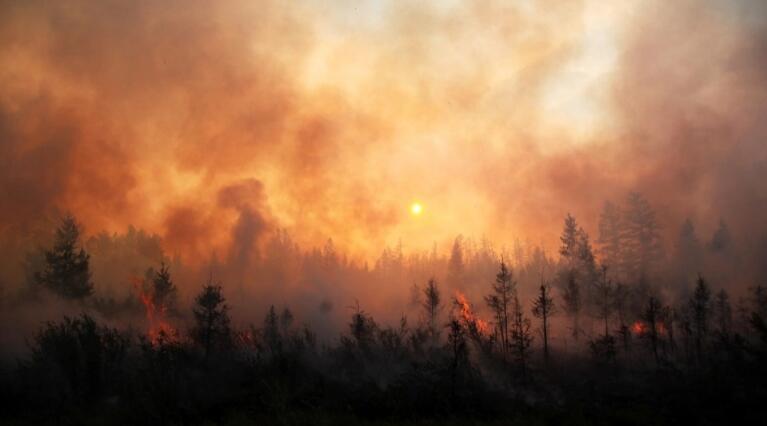On April 22, 2021, the Russian Emergency Services Department reported that an extremely unusual fire broke out in the Omsk region in southwestern Siberia. A forest fire occurred within thousands of square kilometers near Omsk, and the smoke had spread eastward for more than 700 kilometers. , Which seriously affected Novosibirsk, Russia’s third largest city, and citizens reported a sharp drop in visibility on the road!
How serious is the fire in Russia?
On April 27, 2021, the “Moscow Times” reported that the city of Novosibirsk has been enveloped by the smoke of the fire. Residents said that they could smell thick smoke on urban roads. The city government of Novosibirsk had issued the “Black Sky” air. As an early warning of serious pollution, local media said that the sun in the sky was as blood red as the setting sun because of the smog in the sky.
Novosibirsk is shrouded in smoke
Omsk is located in western Siberia, on the northern border with Kazakhstan.
Image taken by NASA’s Aqua satellite
On April 22, 2021, the Medium Resolution Imaging Spectrometer (MODIS) of the Aqua satellite obtained color images of fires burning near and in the north of Omsk, Russia.
Satellite image of the European Union Copernicus Sentinel-2
On April 24, the Copernicus Sentinel-2 satellite obtained satellite images of the ongoing fires in the Omsk region of southwestern Siberia, Russia. There are a dense number of fire spots near Omsk.
Judging from the Russian firefighting map, this year’s Russian wildfires came a bit early and the area is larger. Judging from the wildfire map, wildfires are happening everywhere in Siberia!
Fire Map of the Russian Fire Department: A blood-red fire map
NASA FIRMS fire maps, mainly in the border areas of Kazakhstan and Russia
Why this year’s wildfire season comes so early
Earlier this year, Russian weather forecasters warned that due to hot and dry weather, Siberian forest fires will increase in 2021, and Russia has set a number of high temperature records in recent years.
Omsk and Novosibirsk
NASA’s weather report
April is a relatively cold month in the Omsk region. Generally, the average temperature is around 8.9°C. However, on April 15, 2021, the temperature in Omsk reached 22.2°C, which is 13°C higher than the average temperature. In addition, with strong winds in April, the wildfire season started earlier!
Planting habits of Russian farmers
Farmers in Siberia, Russia, are not very good in farming habits. They burn the weeds and stalks left in the farmland before planting in spring each year. In April, near Novosibirsk and Omsk, not only did the temperature rise this year, but also accompanied by it. Strong winds and uncontrollable fires directly spread to nearby forests, causing fires that spread but could not be extinguished.
Environmentalists are also accusing Russia. The increase in forest fires in recent years is inseparable from the lack of effective forest management in the region, and the government’s low investment in forest fire prevention has a lot to do with it.
The sequelae of global warming: the flames under the ice cannot be extinguished
An indisputable fact is happening. Wildfires in Siberia are increasing every year. Of course, this also includes Alaska and northern Canada. Behind the increase in wildfires is the increasing high temperature near the Arctic Circle since global warming. The high temperature record is on June 20, 2020 in the small town of Yansk in Siberia. The temperature reached 38°C, while the local average temperature in June was 18°C.
With high temperature, dryness and strong winds, fires in these areas seem inevitable, but a report on EcoWatch on June 1, 2020 made people shudder, because some wildfires may not have occurred in the past year, maybe last year Even the year before last!
On April 17, 2020, two firefighters from the Mat-Su area of the Alaska Forest Service found smoke emitting near Rolly Creek in Willow Swamp during their inspection. Their handheld thermal imager found that the ground temperature was 123°C- 198°C, obviously there is a fire in the ground!
However, there was no fire on the ground, and even most of the area was still covered by snow. There was a fire in August 2019, and the fire was extinguished, and it was covered by snow when the winter came.
Zombie fires can continue to burn underground
Jessica McCarty, an Arctic Fire researcher and assistant professor at the Department of Geography of the University of Miami, said that the zombie fire can reach the ground as soon as the ice melts and form a new fire!
This is determined by the special morphology of the peat layer. Peat is a coarse humus layer formed by peatification. It can also be said to be the coal with the lowest degree of coalification. In peat swamp areas, people often use it as a fuel. The high temperature in the Arctic will It will dry the peat layer, lightning strike or fire can ignite the peat layer, there are a lot of gaps in the peat layer, the interior is full of methane and oxygen, so this smoldering can last for months or even years!
Therefore, after the snow melts in the next year, the peat layer will return to the ground. If there are suitable combustibles around, it will cause a fire again. Two firefighters from the Mat-Su area found it near Rolly Creek in Willow Swamp. The fire is the zombie fire of this peat layer.
Schematic diagram of peat layer distribution and wildfire distribution
Most of the peat layers are located in high latitude areas, such as Siberia in Russia and Alaska in the United States, Yukon and Nuvut in Canada, and the Nordic region. Greenland is also covered with a large amount of peat layers. The global peat area has reached 4.1 million square kilometers. , Accounting for about 3% of the world’s land area, there is no doubt that these are hidden dangers, and this kind of fire cannot be extinguished!
Coal seam fire
The fire in the peat layer is the same as the coal fire. This is a world problem, but the consequences are very serious. The European Union Copernicus Atmospheric Monitoring Agency has determined that many fires in the Arctic Circle are caused by zombie fires in the peat layer!
With the advent of the high temperature season, the snow in the Arctic Circle gradually melts. This year’s wildfire situation will be very severe, and it will release astronomical amounts of carbon dioxide into the atmosphere every year, which will promote global warming faster, please ask this question Is there a solution?






